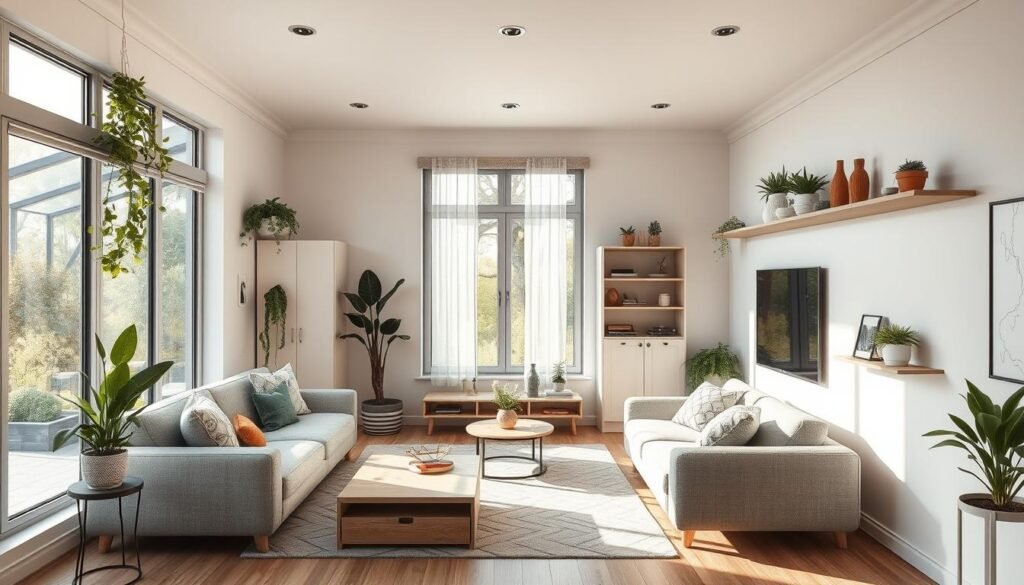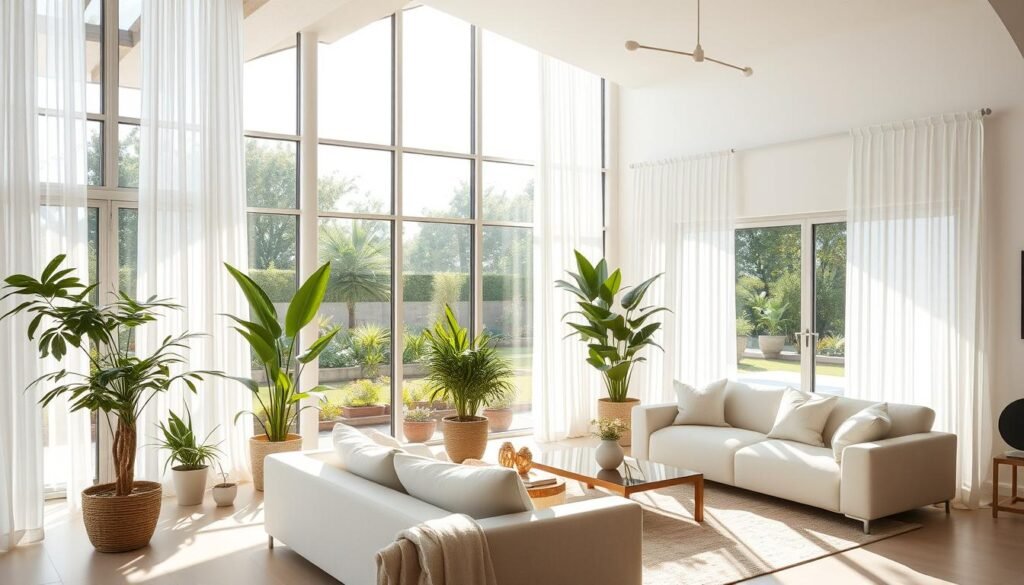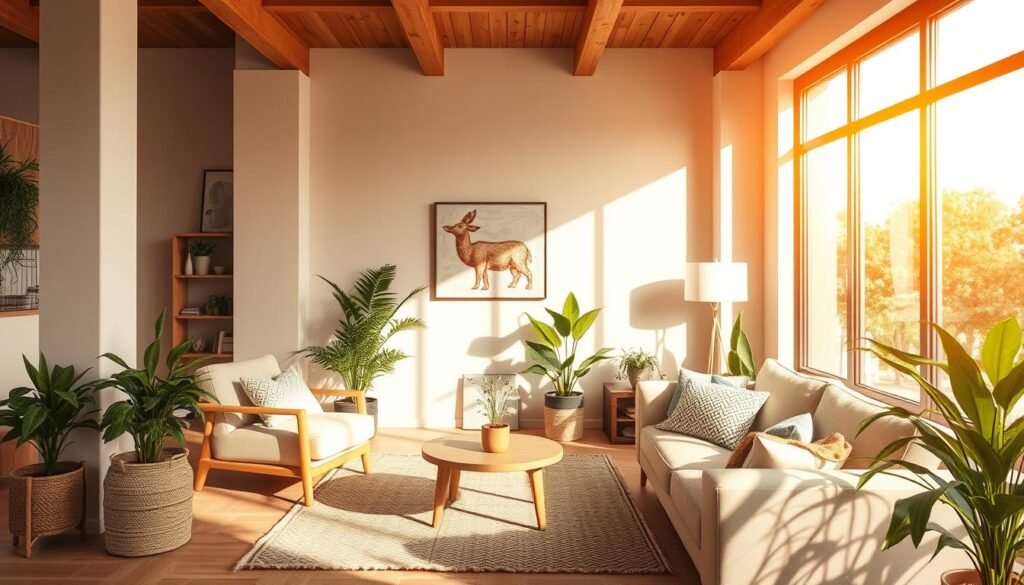As I enter my living room, I feel calm and cozy. This room is a mirror of my style and a peaceful escape. If you’re looking for a space that’s both beautiful and functional, you’re in the right place. We’ll explore how to make your living area your perfect retreat.
Key Takeaways
- Understand the fundamental design principles to create a cohesive and visually appealing living space.
- Explore strategies for maximizing your square footage and optimizing space utilization.
- Discover the importance of natural light and ventilation in enhancing the ambiance of your living area.
- Learn how to choose the right color scheme and materials to elevate the aesthetic of your space.
- Incorporate smart storage solutions to keep your living area organized and clutter-free.

Understanding the Fundamentals of Living Area Design
Creating a great living area starts with knowing the basics. It’s about finding the right balance and thinking about scale and proportion. These ideas help make a space that shows off your style and fits your life.
Basic Design Principles
A good living area design follows key principles. Balance, rhythm, emphasis, and harmony are at the heart of it. Balance makes the space look good, rhythm adds interest, and emphasis highlights key points. When these come together, you get a welcoming and unified area.
Elements of Spatial Planning
- Zoning: Breaking the area into zones like seating, dining, and entertainment helps keep things organized.
- Traffic Flow: Planning how people move around makes the space more comfortable and less crowded.
- Spatial Relationships: Knowing how different parts of the space relate to each other is key to a smart design.
Understanding Scale and Proportion
The size and shape of things in your living area matter a lot. They help make the space look balanced and nice. Choosing the right sizes and places for furniture and decor is crucial for a space that looks good and feels right.
“The living area is the heart of the home, where we gather, relax, and create lasting memories. Understanding the fundamentals of design is essential for crafting a space that is both beautiful and functional.”
Maximizing Square Footage for Optimal Space Utilization
Designing an efficient living area means using every square inch wisely. Clever strategies can make small rooms feel bigger. This includes smart furniture choices and creative storage ideas.
Furniture Placement for Space Optimization
Choosing the right furniture layout can greatly impact a room’s feel. Opt for multi-functional pieces like ottomans with storage or modular sofas. These save space without sacrificing style.
Placing furniture against walls also makes rooms look larger. It helps create a clean, open look.
Innovative Storage Solutions
Good storage is key to using space well. Use built-in shelves, wall units, and furniture with secret spots to stay organized. Vertical storage, like tall bookshelves, is especially useful for making the most of room dimensions.
| Space-Saving Furniture | Dimensions | Storage Capacity |
|---|---|---|
| Convertible Sofa Bed | 84″ x 36″ x 36″ | 4 cubic feet |
| Storage Ottoman | 36″ x 36″ x 18″ | 18 cubic feet |
| Wall-Mounted Shelving Unit | 72″ x 12″ x 6″ | 12 cubic feet |
With these strategies, you can make the most of your square footage. Your living area will be both useful and beautiful.

Planning Your Perfect Floor Plan Layout
Creating the ideal living area starts with the floor plan layout. Homeowners and designers can choose between open concept and traditional layouts. Each has its own benefits, depending on your lifestyle and space needs.
Open Concept vs. Traditional Layouts
Open concept floor plans are very popular today. They blend the kitchen, living, and dining areas into one. This layout makes your space feel open and improves circulation flow.
On the other hand, traditional layouts have separate rooms. They offer privacy and a clear purpose for each area.
Traffic Flow Considerations
Every floor plan should focus on traffic flow. By planning entryways, walkways, and activity zones, you can avoid congestion. Place furniture and architectural elements wisely to keep the flow smooth.
Zoning Different Activities
In an open concept design, it’s key to zone activities. Set up areas for relaxing, entertaining, dining, and working. This way, each area serves its purpose while looking good together.
Use furniture and visual cues like area rugs or lighting to define these zones. This makes your open floor plan functional and beautiful.

By looking at various floor plans, focusing on traffic flow, and zoning activities, you can make a space that looks great and works well. Finding the right mix of open concept and traditional layouts can make your living space truly special.
Incorporating Natural Light and Ventilation
Adding natural light and fresh air can change how your living area feels and works. Think about where to put windows and mirrors. These can help make your space brighter and more open.
Mirrors are great for reflecting light. They make rooms look bigger and brighter. Try different sizes and places to see what works best for your area.
- Strategically place mirrors across from windows to maximize natural light reflection
- Opt for large, statement mirrors to create a focal point and enhance the sense of space
- Use mirrored furniture, such as a coffee table or console, to further increase the natural light distribution
Choosing the right window treatments is also key. Light, thin curtains or blinds are better than heavy ones. They let in more light and air.
| Window Treatment | Impact on Natural Light | Impact on Ventilation |
|---|---|---|
| Sheer Curtains | Allow maximum light transmission | Facilitate airflow without obstructing windows |
| Vertical Blinds | Provide adjustable light control | Facilitate airflow when opened |
| Roman Shades | Offer moderate light control | Partially obstruct airflow when down |
Using these ideas can make your living area look good and work well. Bright, airy spaces with good air flow make your home feel welcoming. It’s a great way to make your living area more enjoyable.

Choosing the Right Color Scheme and Materials
Creating the perfect living area is more than just the layout. The right colors and materials can change a space, making it beautiful and welcoming. It’s important to know how colors and materials work together to create a space that feels right.
Color Psychology in Living Spaces
Colors can make us feel certain ways and set the mood of a room. Warm colors like reds and oranges make a space feel cozy and lively. Cool colors, such as blues and greens, bring calm and peace. Neutral colors, like grays and beiges, are great because they let you add pops of color easily.
Think about what mood you want your living area to have. This will help you pick the best colors.
Material Selection Guide
The materials in your living area affect how it looks and works. Hard, easy-to-clean surfaces like hardwood or tile are good for busy areas. Soft materials, like plush fabrics, add warmth and interest.
When picking materials, think about how easy they are to care for, if they’re good for the planet, and how they match your colors.
Texture Combinations
- Using different textures makes your space utilization more interesting and inviting. Mix smooth with rough, matte with glossy, and soft with hard.
- Try out various materials, like wood, stone, metal, and fabrics, to add depth and layers to your design.
- Make sure the textures you choose work well together for a balanced and harmonious look.

“The right colors and materials can transform a living space, making it a true reflection of your personal style and creating a welcoming atmosphere for all who enter.”
Smart Storage Solutions for Living Area Organization
Creating a clutter-free living area is easier with smart storage solutions. These solutions help you use storage space wisely. This way, your living space becomes a place that shows your style and is functional.
Built-in storage is a great idea. Options like wall-mounted shelves, cabinets, or recessed alcoves work well. They make the most of room dimensions and keep your area looking neat.
- Use wall-mounted shelves to show off decorations and keep essentials handy.
- Choose furniture that does more, like ottomans or coffee tables with secret storage.
- Make the most of corners with custom storage or built-in cabinets.
Multi-functional furniture is also smart. Items like storage ottomans, sofa beds, and modular shelves are both stylish and useful.
“Efficient storage solutions are the key to a clutter-free and visually appealing living space.”
To make the most of space utilization, think up. Use wall space with floating shelves, hanging baskets, or wall-mounted storage. This saves floor space and adds interest to your area.

With these smart storage tips, you can turn your living area into a peaceful, organized space. Every item will have its place, and your room dimensions will be used to their fullest potential.
Creating Multi-functional Living Area Spaces
In today’s world, the living area is more than just a place to relax. It’s a hub where different parts of our lives come together. This includes flexible furniture and space ideas that change with our needs.
Flexible Furniture Arrangements
Start by placing furniture in smart ways. Use modular sofas, adjustable tables, and stackable chairs. These items let you change the space for different activities.
Try out different layouts to turn your living area into a cozy lounge, a workspace, or a dining spot. This way, it fits your changing lifestyle.
Convertible Space Ideas
Adding convertible designs makes your living area even more versatile. Think about murphy beds, transforming desks, and multi-purpose storage. These items help you use the space for work, rest, and fun.
They also help keep your living area tidy and make the most of space utilization.
Work-Life Balance Solutions
With remote work, the living area is key for balancing work and life. Create a dedicated work zone within the layout. This keeps you productive while keeping your living space peaceful.
Choose designs that hide storage and look good. This makes your workspace part of the living area’s beauty.
Using these design ideas, you can make your living area a dynamic space. It meets your changing needs, blending function and beauty.
Lighting Design Strategies for Ambiance
Lighting is key in setting the mood of your living area. By using smart lighting techniques, you can change the space’s feel. This makes it warm and welcoming, just how you like it. Let’s look at some ideas to improve the light and layout of your living area.
Layer Your Lighting
Layered lighting uses different lights to add depth to your space. You can mix ambient, task, and accent lighting. Ambient lights, like ceiling fixtures, give overall light. Task lights, like table lamps, focus on specific areas for activities.
Accent lights, such as track lights, highlight special features or art. This adds interest to your space.
Harness the Power of Natural Light
Use natural light to brighten your living area. Big windows, skylights, or sliding doors are great for this. Mirrors can also reflect light, making the space feel brighter and more open.
Pair natural light with sheer curtains or blinds. This lets you control the light and create a cozy feel.
| Lighting Technique | Benefits |
|---|---|
| Layered Lighting | Provides depth, dimension, and versatility in lighting the living area |
| Harnessing Natural Light | Enhances the overall brightness and ambiance of the living space |
| Smart Lighting Solutions | Offers convenience, energy efficiency, and customizable lighting control |
Embrace Smart Lighting Solutions
Smart lighting, like dimmable LEDs and motion sensors, gives you control over your space’s mood. You can change the light’s brightness, color, and timing. This makes your living area perfect for any activity.
“Lighting has the power to transform a space, evoking emotions and shaping the overall aesthetic of a room.”
By using these lighting strategies, you can make your living area beautiful and welcoming. It will feel just right for you.
Incorporating Personal Style and Character
Turning your living area into a space that shows your style and character is rewarding. Choose and arrange accessories, display your collections, and place decor pieces with care. This way, you can make your living area lively and welcoming.
Accessorizing Your Space
Accessories make your living area come alive. Think about decorative throw pillows, cozy blankets, striking vases, and unique lighting. The right accessories can make your space look good and feel cohesive.
Try mixing textures, patterns, and colors. This adds interest and shows off your style.
Art and Decor Placement
How you arrange art and decor affects your living area’s feel. Think about balance, symmetry, and flow. Hang art at eye level and group similar pieces together.
Use different heights and sizes to add depth. This makes your space more interesting and visually appealing.
Personal Collections Display
- Use dedicated shelves or cabinets to show off your collections, like books, figurines, or souvenirs. This keeps them organized and looks good.
- Display personal photos, family heirlooms, and special mementos. This makes your space feel lived-in and personal.
- Change up your displays now and then. This keeps your living area feeling fresh and shows your changing interests.
By adding your personal style and character to your living area, you create a warm and inviting space. It truly reflects your unique personality and tastes.
“Your home should tell the story of who you are, and be a collection of what you love.” – Nate Berkus
Budget-Friendly Design Solutions
Creating your dream living area doesn’t have to cost a lot. With some creativity and smart use of space, you can make your space look great without spending a lot. This section will show you how to get a high-end look on a budget.
DIY Decor Hacks
Get creative and become your own designer with DIY projects. You can give old furniture a new life, make your own art, or upholster a piece. These ideas not only save money but also make your layout unique.
- Refinish thrift store finds for a designer-inspired look
- Unleash your creativity with DIY wall art and decor
- Reupholster a dated couch or chair to revive your space
Affordable Decor Finds
Look for hidden gems at thrift stores, garage sales, and online. You can find vintage pieces and modern furniture that won’t empty your wallet. These finds help you create a stylish and personal space utilization.
- Scour thrift stores and secondhand shops for unique decor pieces
- Explore online marketplaces for affordable furniture and home accessories
- Mix high-end and budget-friendly elements for a curated layout
Repurposing and Upcycling
Give new life to old items by repurposing and upcycling. Turn old furniture into unique pieces, make decorative items from everyday objects, and find creative ways to use your space.
| Before | After |
|---|---|
| Dated dresser | Upcycled dresser-turned-TV stand |
By using budget-friendly design ideas, you can make a beautiful and useful living area. It will show off your style and meet your space utilization needs, all while staying within your budget. Let your creativity shine and enjoy making your space better without spending a lot.
Sustainable and Eco-Friendly Design Choices
When planning your dream living area, think about eco-friendly design options. These choices make your space beautiful and good for the planet. Let’s look at some ways to add green principles to your design.
Green Materials Selection
The materials you pick for your living area matter a lot. Choose bamboo, reclaimed wood, natural stone, and low-VOC paints. These options are good-looking and help save resources and cut down on carbon emissions.
Energy-Efficient Solutions
Energy efficiency is key for a green living area. Use energy-saving windows, LED lights, and smart home tech to cut down on energy use. Also, add passive design features like smart window placement and natural air flow to make your space even greener.
Sustainable Furniture Options
Choosing sustainable furniture is important. Look for pieces made from renewable, recycled, or reclaimed materials. This includes organic cotton, hemp, or wood certified by the FSC. Quality, long-lasting furniture helps reduce waste and supports a sustainable lifestyle.

Hello, I’m Jane, founder of Home Vibe Ideas. I’m here to inspire stylish Home Design, modern Smart Living, beautiful Outdoor Spaces, and creative DIY Projects to help you create a home that’s uniquely yours.
Disclosure: This post contains affiliate links. If you click on a link and make a purchase, we may earn a small commission at no additional cost to you. The content on this site was created with the help of AI technology.


